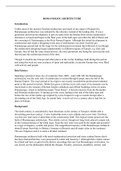Essay
ROMANESQUE ARCHITECTURE: Design, Brief history, recent revival in America
- Course
- Eng103 (ENG103)
- Institution
- Thompson River University (TRU )
Introduction Unlike most of the ancient Christian architecture and much of any aspect of human life, Romanesque architecture was initiated by the citizenry instead of the leading elite. It was a grassroots down-top development. It gets its name from the Roman from whose architectural elements it i...
[Show more]



